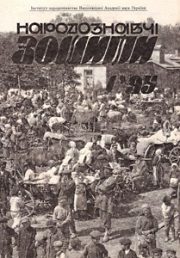The Ethnology Notebooks. 2020. # 6 (156), 1287—1296
УДК 72/75:910.4
DOI https://doi.org/10.15407/nz2020.06.1287
Olena SOM-SERDYUKOVA
- ORCID ID: http://orcid.org/0000-0001-5196-545X
- Associate Professor, Doctor of Philosophy (Art Science),
- Doctoral Student the Department of Design and Technology
- of the Kyiv National University of Culture and Arts,
- 36, E. Konovaltsya Str., 01133, Kyiv, Ukraine,
- email: olenasom@gmail.com
BUNAD — NATIONAL COSTUME OF NORWAY: TRADITION AND CONTEMPORARY
Bunad, the national costume of Norway, is an important attribute, a kind of symbol and element of identification. This topic has never been covered in domestic art history. Therefore, a comprehensive analysis of the phenomenon of Norwegian culture is quite relevant in the Ukrainian context. The purpose of the article is to consider the essence of the phenomenon of bunad, which is a prominent example of dialogue between tradition and contemporary in the context of Norwegian society. The topic of the article is a study of the revival of interest in folk clothing among the local intelligentsia in the nineteenth century and an analysis of the factors of the spread of the tradition of bunads in the twentieth and twenty-first centuries. The bunad is the object of our exploration, and the subject is the evolution of attitudes toward the bunad over the last 200 years. The research methodology is based on theoretical analysis, systematization and generalization, historical review and observations of the author. G. Harborg’s ascetic activity on fixation, research and popularization of bunades is covered. The peculiarity of its modern form is considered, which is a design solution and, at the same time, keeps the man-made tradition unchanged. Attention is drawn to the parallels in the regional development of bunads and language dialects. The focus is on their diversity and high artistic and aesthetic quality. The problem of professional control over their quality has been raised, which is part of the activities of the National Institute of Bandages and Folk Costume. The activity of the institution is studied and the main directions of work are evaluated, such as: fundamentas studies, creation of reconstructions and access with the recommendations bunad usage. It is noted that the phenomenon of bunades, gives the opportunity to make exciting journeys through Norwegian culture in time and space. This creates a reason to touch the aspect where the exclusive characteristic of the bunad is connected to the cultural landscape of Norway.
Keywords: bunad, national costume, folk clothes, design, handmade, tradition, cultural landscape, Norway.
REFERENCES
- Garborg, H. (2016). Norwegian bunad. Oslo: Viderforlaget [in Norwegian].
- Skavhaug, K. (1978). Our beautiful bunads. Oslo: Hjemennes forlags A/S [in Norwegian].
- Pedersen, K-A. (2013). Folk costume became a bunad. Oslo: Cappelen Damm Faktum [in Norwegian].
- Durån, L. (2014). Popular national costumes. Oslo: Duranpublishing [in Norwegian].
- Andersen, T. (2013). Sew the bunad. Oslo: Ornforlag [in Norwegian].
- Fossnes, H. (Ed.). (2019). Cap. An important part of the bunad. (Magasinet Bunad). Skien: Smøyg Forlag [in Norwegian].
- Scheel, E.W. (2001). Norwegian costumes. Stretchers and bunads: living traditions. Oslo: N.W. Damm & Søn [in Norwegian].
- Scheel, E.W., & Ødegården, I.H. (1997). Bunad- embroidery. Oslo: Boksenteret forlag [in Norwegian].
- Skårdal Tobiasson, T. (2019). Folk costume in our time. Oslo: Orfeus [in Norwegian].
- Noss, A. (2012). Women’s clothing in Sogn. Example of a western Norwegian traditional dress code. Oslo: Novus forlag [in Norwegian].
- Hovland, B. (2014). Folk costumes and bunad from Sogn. A journey in time and landscape. Bergen: Skald [in Norwegian].
- Hol Haugen, B.S. (Ed.). (2006). Norwegian bunad leksikon (Bind I). Oslo: N.W. Damm & Søn [in Norwegian].
- Hol Haugen, B.S. (Ed.). (2006) Norwegian bunad leksikon (Bind II). Oslo: N.W. Damm & Søn [in Norwegian].
- Hol Haugen, B.S. (Ed.). (2006). Norwegian bunad leksikon (Bind III). Oslo: N.W. Damm & Søn [in Norwegian].
- Bunad og folke dress. Retrieved from: https://bunadogfolkedrakt.no/ (Last accessed: 02.11.2020) [in Norwegian].
- Digitaltmuseum. Retrieved from: https://digitaltmuseum.no/ (Last accessed: 02.11.2020) [in Norwegian].
- Bryne, A. (2004). They painted Norway. Oslo: Andresen & Butenschøs AS.
- Mohr, V. (2003). Our craftsmanship. Oslo: C. Huitfeldt forlag A.S [in Norwegian].
- Cold, B. (2010). It’s good to be here. About aesthetics in the environment Trondheim: NTNU [in Norwegian].
- Eriksen, A. (2009). Museum of cultural history. Oslo: Pax forlag A/S [in Norwegian].
- Dahl, E., Larsen, E. & Johansen, R. (2000). Akantus. Oslo: Samlaget [in Norwegian].






